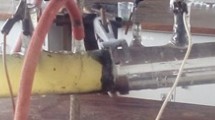Abstract
The electrochemical production of Fenton's reagent by simultaneous reduction of dioxygen and ferric ions on a carbon felt electrode, permits a controlled, in situ generation of hydroxyl (OH·) radicals. The possibility of using electrochemically produced OH⋅ radicals for solving environmental problems is investigated. Continuous and controlled production of hydroxyl radicals was achieved by electrochemical reduction of O2 in the presence of a catalytic amount of ferric or ferrous ion. These radicals are used for remediation of water containing toxic-persistent-bioaccumulative organic pollutants through their transformation into biodegradable compounds or through their mineralization into H2O and CO2. A widely used herbicide, 2,4-dichlorophenoxyacetic acid (2,4-D), was selected as a model for a toxic organic pollutant. High pressure liquid chromatography (HPLC) was used to quantify the distribution of the hydroxylated products obtained. Rate constants for the hydroxylation reactions of 2,4-D, 2,4-dichlorophenol (2,4-DCP), 2,4-dichlororesorcinol (2,4-DCR) and 4,6-dichlororesorcinol (4,6-DCR) were determined. The mineralization of 2,4-D and its derivatives was followed by total organic carbon (TOC) measurements. More than 95% of 2,4-D and the intermediates generated during the electrolysis can be mineralized.
Similar content being viewed by others
References
O. Legrini, E. Oliveros and A.M. Braun, Chem. Rev. 93 (1996) 671.
P.M. Bersier, L. Carlsson and J. Bersier, Electrochemistry for a better environnement, in ‘Topics in Current Chemistry, Electro-chemistry, V’ (Springer Verlag, 1994).
J. Gassmann, J. Voss and G. Adiwidjaja, Z. Naturforsch. 50b (1995) 953.
P.L. Cabot, M. Centelles, L. Segarra and J. Casado, J. Electrochem. Soc. 144 (1997) 3749.
S. Stucki, R. Kötz, B. Carcer and W. Suter, J. Appl. Electrochem. 21 (1991) 99.
C. Pulgarin, N. Adler, P. Peringer and Ch. Comninellis, Wat. Res. 28 (1994) 887.
Ch. Comninellis and C. Pulgarin, J. Appl. Electrochem. 21 (1991) 703.
Ch. Comninellis and C. Pulgarin, J. Appl. Electrochem. 23 (1993) 108.
N.B. Tahar and A. Savall, J. Electrochem. Soc. 145 (1998) 3427.
O. Kargina, B. MacDougall, Y.M. Kargin and L. Wang, J. Electrochem. Soc. 144 (1997) 3715.
P. Ribordy, C. Pulgarin, J. Kiwi and P. Péringer, Water Sci. Tech. 35 (1997) 293.
E. Brillas, R. Sauleda and J. Casado, J. Electrochem. Soc. 145 (1998) 759.
I.F. Cheng, Q. Fernando and N. Korte, Environ. Sci. Technol. 31 (1998) 1074.
A.I. Tsyganok, I. Yamanaka and K. Otsuka, Chem. Lett. (1988) 303.
Ch. Comninellis and A. Nerini, J. Appl. Electrochem. 25 (1995) 23.
Y.L. Hsiao and K. Nobe, J. Appl. Electrochem. 23 (1993) 943.
O. Koyama, Y. Kamagata and K. Nakamura, Water Res. 28 (1994) 895.
H.J.F. Fenton, J. Chem. Soc. 65 (1894) 8234.
C. Walling, Acc. Chem. Res. 8 (1975) 125.
M.A. Oturan, J. Pinson, D. Deprez and B. Terlain, New J. Chem. 16 (1992) 705.
M.A. Oturan and J. Pinson, J. Phys. Chem. 99 (1995) 13948 and references cited therein.
A. Tsyganok, K. Otsuka, I. Yamanaka, V. Plekhanov and S. Kulikov, Chem. Lett. 4 (1996) 261.
D.C. Coomber, D.J. Tucker and A.M. Bond, J. Electroanal. Chem. 426 (1997) 63.
Y. Sun and J.J. Pignatello, J. Agric. Food Chem. 40 (1992) 322.
R. Bauer and H. Fallmann, Res. Chem. Intermed. 23 (1997) 341.
Y. Sun and J.J. Pignatello, Environ.Sci. Technol. 27 (1993) 304.
L. Sanchez, J. Peral and X. Domenech, Electrochim. Acta 41 (1996) 1981.
M. Trillas, J. Peral and X. Domenech, Appl. Catal. B 5 (1995) 377.
M.A. Oturan, J.J. Aaron, N. Oturan and J. Pinson, Pestic. Sci. 55 (1999) 558.
P. Pichat, J.C. D'Oliveira, J.F. Maffreand and D. Mas, Trace Met. Environ. 3 (1993) 683.
M. Trillas, L. Sanchez, J. Peral and X. Domenech, Proc. Electrochem. Soc. (1994) 290.
E. Camarro and S. Esplugas, J. Chem. Technol. Biotechnol. 57 (1993) 273.
G.S. Kochar and R.S. Kahlon, J. Gen. Appl. Microbiol. 41 (1995) 367.
B. Kuhlmann and B. Kaczmarzcyk, Environ. Toxicol. Water Qual. 10 (1995) 119.
R. Tomat and A. Rigo, J. Appl. Electrochem. 9 (1979) 301.
R. Tomat and A. Rigo, J. Appl. Electrochem. 14 (1984) 1.
T. Tzedakis, A. Savall and M.J. Clifton, J. Appl. Electrochem. 19 (1989) 911 and references cited therein.
G.V. Buxton, C.L. Greenstock, W.P. Helman and A.B. Ross, J. Phys. Chem. Ref. Data 17 (1988) 513.
M.A. Oturan, J. Pinson, J. Bizot, D. Deprez and B. Terlain, J. Electroanal. Chem. 334 (1992) 103.
M.K. Eberhardt and M.L. Martinez, J. Phys. Chem. 79 (1975) 1917.
M.K. Eberhardt, J. Phys. Chem. 81 (1975) 1051.
J.R. Lindsay Smith and R.O.C. Norman, J. Chem. Soc. (1963) 2897.
N.V. Raghavan and S. Steenken, J. Am. Chem. Soc. 102 (1980) 3495.
X-M. Pan, M.N. Schuchmann and C. von Sonntag, J. Chem. Soc. Perkin Trans. 2 (1993) 289.
G. Merga, H-P. Schucmann, B.S. Madhava Rao and C. von Sonntag, J. Chem. Soc. Perkin Trans. 2 (1996) 1097.
A.B. Thomsen, Water Res. 32 (1998) 136.
M.I. Stephan and J.R. Bolton, Environ. Sci. Technol. 32 (1998) 1588.
E. Brillas, R.M. Bastida, E. Llosa and J. Casado, J. Electrochem. Soc. 142 (1995) 1733.
Author information
Authors and Affiliations
Rights and permissions
About this article
Cite this article
Oturan, M. An ecologically effective water treatment technique using electrochemically generated hydroxyl radicals for in situ destruction of organic pollutants: Application to herbicide 2,4-D. Journal of Applied Electrochemistry 30, 475–482 (2000). https://doi.org/10.1023/A:1003994428571
Issue Date:
DOI: https://doi.org/10.1023/A:1003994428571




